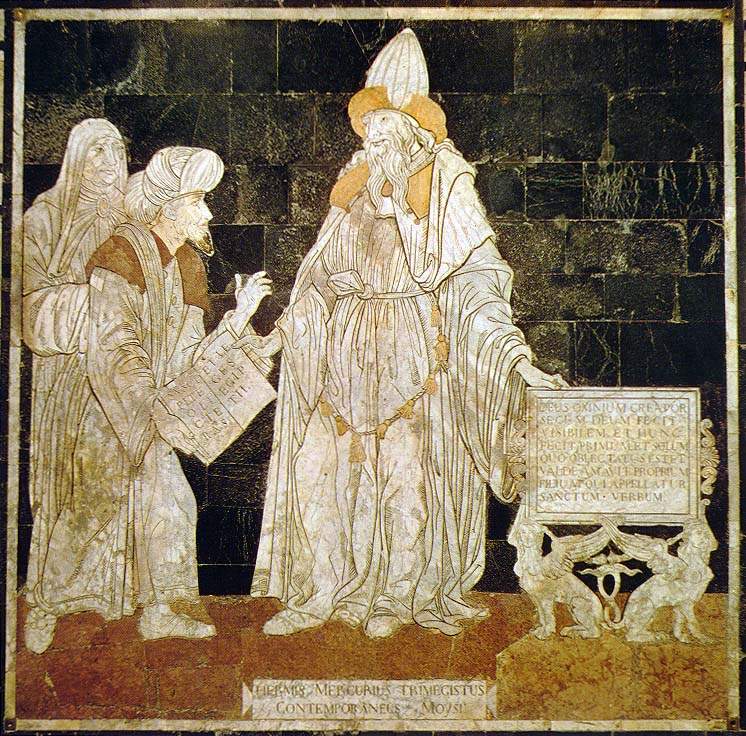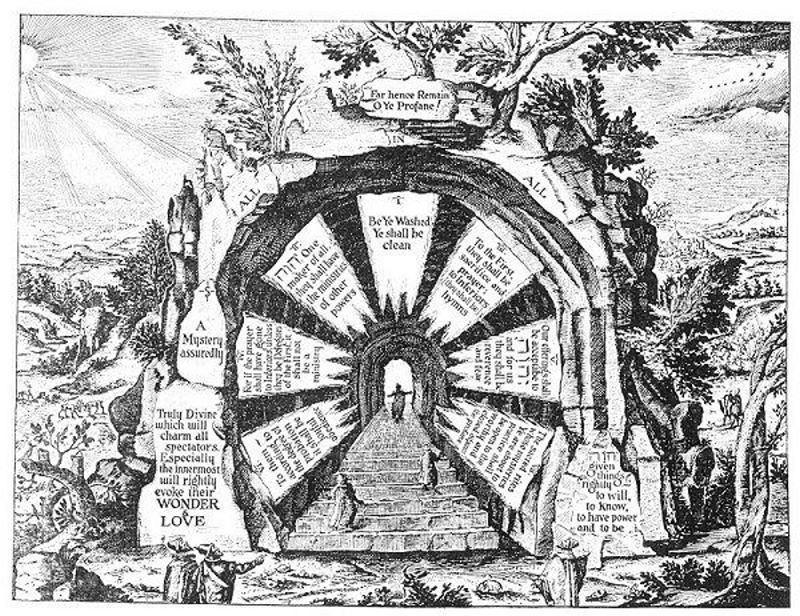
Wiki / HermesTrismegistos
Inhaltsverzeichnis: (verbergen)
|
༺·❄·༻

Hermes Trismegistus
༺·❄·༻
|
|
༺·❄·༻
He who wants to get insight and enlightenment in all truth, think of God’s birth in himself, in the depth of his soul. As soon as he will open himself for that, all energies of the soul come to life,
Meister Eckhart O.P. (Eckhart of Hochheim) (1260-1328) German mystic,
༺·❄·༻
|
|
Nachbildung des Alchemielabors, von Andreas Libavius, deutscher Arzt, Philosoph, Chemiker Rathaus Rothenburg ob der Tauber, Historiengewölbe Die "Herstellung" (Transmutation) von Gold (Goldsyn-
Das Opus Magnum ("Großes Werk das dich vollendet") passiert insgesamt 18 Stufen der Universellen Lehre:
|
| Quelle: ► Universelle Lehre |
|
|
|
| Referenz: ► Videopräsentation Die sieben hermetischen Gesetze, präsentiert von dem YouTube-Kanal, Sprecherin Julia Philippi, YouTube Film, 7:17 Minuten Dauer, eingestellt 3. November 2012 |
|
Die Tabula Smaragdina ist ein Zitat aus dem Geheimbuch der Schöpfung. Sie dient als Grundlage der Alchemie. Das 1908 von den drei Eingeweihten veröffentlichte Kybalion, das die Sieben hermetischen Prinzipien beschreibt, beruft sich auf dieses Werk. Metaphysiker betrachten die Tabula Smaragdina als Sammlung grundlegender Wahrheiten. In Symbolsprache beschreibt das Zitat alle vier Phasen des Großen Werks der Wandlung (Transmutation). |
Übersetzungsversionen der Tabula Smaragdina
Tabula Smaragdina, präsentiert von chemie.de/lexikon
|
|
| Quelle: ► Text Tabula Smaragdina von Hermes Trismegistos, Neuübersetzung von Hans Dieter Leuenberger (1931-2007) Schweizer Pfarrer, Psychotherapeut, Esoteriker, 2006 |
| ||||||||||||||||||||||||||||||||||||||||||||||||||||||||||||||||||||||||||||||||||||||||||
| Quelle (engl.): ► Übersicht VI. Correspondences of Physiological Alchemy [VI. Entsprechungen der physiologischen Alchemie], vorgestellt von der Publikation Alchemylab.com, undatiert |
| Siehe auch: ► Körperlichkeit |
| |||||||||||||||||||||||||||||||||||||||||||||||||||||||||||||||||||
| Quelle (engl.): ► Übersicht I. Correspondences of Chemical References [I. Entsprechungen der chemischen Referenzwerte], vorgestellt von der Publikation Alchemylab.com, undatiert |
Einsicht

Literaturzitate
Personal avowals
Mystical poetry
Artephius (~*1130/1150) Jewish or Arabic hermetic philosopher, writer of alchemical texts
|
Francis Bacon [William Shakespeare] (1561-1626) English philosopher, statesman, scientist, lawyer, jurist, pioneer of the scientific method, author
|
Roger Bacon, O.F.M. (1214-1294) [Doctor Mirabilis] English philosopher, scholastic accolade, Franciscan friar, alchemist
|
Petrus Bonus fourteenth century Italien physician at Ferrara, writer on alchemy
|
Marsilio Ficino [Marsilius Ficinus] (1433-1499) Italian Renaissance humanist philosopher, astrologer,
first translator of Plato's complete extant works into Latin, reviver of Neoplatonism
|
Benedictus Figulus (1567-missing since 1619) German alchemist, proponent of Paracelsism, pastor, poet, publisher in the early 17th century
|
|
Nicolas Flamel (~1330-~1413/1418) French alchemist, manuscript-seller, scrivener, author
|
|
Fulcanelli [Pseudonym] (*1877) French alchemist, esoteric author
|
|
Henry Madathanas
|
The Golden Age Restored, 38 pages, first released 1622, CreateSpace Independent Publishing Platform, 4. December 2011 |
Albertus Magnus, O.P. [Albert the Great, Albert of Cologne] (1193/1206-1280) German Dominican friar, bishop,
Roman Catholic Doctor of the Church, saint, 1931
|
Michael Maier
|
John A. Mehung
|
|
Henry Nollius (1582-1626)
|
Thomas Norton (1433-1513) English alchemist, poet
|
Paracelsus [Philippus von Hohenheim] (1493-1541) Swiss Renaissance physician, botanist, philosopher, astrologer, alchemist, general occultist
|
|
Paracelsus (born Philippus Aureolus Theophrastus Bombastus von Hohenheim, 11 November or 17 December 1493 in Einsiedeln – 24 September 1541 in Salzburg) was a Renaissance physician, botanist, alchemist, astrologer, and general occultist. "Paracelsus", meaning "equal to or greater than Celsus", refers to the Roman encyclopedist Aulus Cornelius Celsus from the 1st century known for his tract on medicine. He is also credited for giving zinc its name, calling it zincum and is regarded as the first systematic botanist. Paracelsus, presented by en.wikipedia |
Creating a clone of a man called by Homunculus Paracelsus
|
Eirenaeus Philalethes [Pseudonym of George Starkey] (1628-1665) British physician, alchemist, author
|
|
Johann Friedrich Schweitzer [John Frederick Helvetius] (1625-1709) Dutch physician of German extraction, alchemical writer
|
Michał Sędziwój [Michael Sendivogius] (1566-1636) Polish medical doctor, pioneer of chemistry, philosopher, alchemist
|
Alexander von Suchten (~1520-1575) German alchemist, physician, poet
|
An Explanation of the Natural Philosopher's Tincture of Theophrastus Paracelsus, 16th century, Kessinger Publishing, 23. May 2010
|
Baro Urbigerus [Baron Urbiger] 17th century writer on alchemy
|
Aphorisms of Urbigerus, London, 1690, presented by the alchemy website |
Count Bernard Trevisan (1406-1490) Italian alchemist
|
Basil Valentine [Basilius Valentinus] Benedictian monk, alchemist, German speaking author
|
Ko Hung, Chinese alchemist
|
Shih Hsing-lin, Chinese disciple of Chang Po-tuan
Hsieh Tao-kuang, Chinese disciple of Shih Hsling-lin
|
Chang Po-tuan, Chinese alchemist
|
|
Brother of the Rosicrucian Fraternity
|
Anonymous German philosopher
|
Anonymous German sage
|
Anonymous German sage
|
Anonymous sage and lover of truth
|
Anonymous
|
Anonymous
|
Anonymous
|
Anonymous
|
Anonymous
|
Anonymous
|
|
Personal avowals

| Quotes by C.G. Jung, the persona, presented by the psikoloji.fisek.com |

| ||||||||||||||||||||||||||||||||||||||||||||||||||||||||||||||||||||||||||||||||||||||||||||||||||||||||||||
| Insight | "We’ve found that leaders who undertake a voyage of personal understanding and development can transform not only their own capabilities, but also those of their companies." Article by David Rooke, William R. Torbert, Ph.D., US American professor, Boston College's Carroll School of Management, Massachusetts, Seven Transformations of Leadership, presented by the bimonthly management magazine Harvard Business Review (HBR), published by Harvard Business Publishing, S. 1-9, April 2005 | |||||||
| Statistics | ➤ 55% of the leaders operate preconventionally, perform below the level of integrity. ➤ 30% of the leaders operate conventionally, perform above the level of integrity. ➤ 14% of the leaders have attained a post-conventional level. ➤ Less than 1% of the leaders operate at transpersonal stages. | |||||||
| Source: ► Article Transformation in Leadership, Part 1: A Developmental Study of Warren Buffett, presented by the Integral Leadership Review, Edward J. Kelly, ~2012 |
| Based on: ► Seven vertical action-logic stages of development (of mental complexity) – originator William R. Torbert, Ph.D., US American teacher, consultant, artist, author, 2004 ► Three orders of consciousness: Adult Levels of Development: Socialized ◊ Self-authoring ◊ Self-transforming – originator Robert Kegan, Ph.D. (*1946) US American developmental psychologist, professor of leadership studies and adult learning, Harvard University, co-director for the Change Leadership Group, author, 1994 |
| Reference: ► Robert Kegan, Ph.D. (*1946) US American developmental psychologist, professor of leadership studies and adult learning, Harvard University, co-director for the Change Leadership Group, author, The Evolving Self. Problem and Process in Human Development, Harvard University Press, 1982, reprint edition 1. July 1983 |
| See also: ► Leadership and ► Ken Wilber and ► Step models ► Chakra system and ► Chakras – Alchemical process |
|
| Source: ► Three Initiates, The Kybalion, chapter II, presented by the free Internet archive Sacred Texts, 1912 |
| Reference: ► Article Hermetic philosophy of ancient Egypt. An appreciation of The Kybalion, and a short study of the hermetic footprints that lead to the Wisdom of ancient Egypt, presented by occult-mysteries.org, 24. January 2015, updated 18. February 2018 |
| Literature: ► Three Initiates (anonymous authors), The Kybalion. A Study of The Hermetic Philosophy of Ancient Egypt and Greece, 1908, Merchant Books, paperback, 1st edition 7. February 2013 |
|
| Source: ► Article A Commentary on the Emerald Tablet, presented by the alchemy web site, undated |
|
| Source: ► Anonymous, The Book of Aquarius. Alchemy and the Philosophers' Stone, released 20. March 2011, updated 13. June 2011, classic reprint, Forgotten Books, 1. June 2011 |
Three are the natures of Mind, carrier it of the Will of the Great One. Arbitrator of Cause and Effect in thy life. Thus is formed the threefold being, directed from above by the power of four. Above and beyond man's threefold nature lies the realm of the Spiritual Self. Four is it in qualities, shining in each of the planes of existence, but thirteen in one, the mystical number. |
| Source: ► Hermes Trismegistos describing the ancient conflict between light and dark, good and evil, on Earth, cited in: deleted blog article by Robert M. Stanley (*1959) US American corporate journalist for HONDA research and development, researcher of UFOs and ETs, owner, operator and radio host of The Unicus Radio Network, author, Who is Hermes? – The Emerald Tablets, presented by The Unicus Magazine Blog, 6. September 2012 |
| See also: ► Principle 3:1 |
| |||||||||||||||||||||||||||||||||||||||||||||||||||||||||||||||||||||||||||
| Source: ► Overview VI. Correspondences of Physiological Alchemy, presented by the publication Alchemylab.com, undated |
| Siehe auch: ► Körperlichkeit |
| |||||||||||||||||||||||||||||||||||||||||||||||||||||||||||||||||||||||
| Source: ► Overview II. Correspondences of Astrology and Numerology, presented by the publication Alchemylab.com, undated |
| See also: ► Numerology and ► Astrology |
| |||||||||||||||||||||||||||||||||||||||||||||||||||||||||||||||||||||
| Source: ► Carl Gustav Jung, Psychology and Alchemy – Collected Works of C. G. Jung, Volume 12, heading "Quartering of the philosophy", S. 229, 1944, Routledge, London, 2nd edition 1968 |
| See also: ► Astrology and ► Philosophy |
| Calcination ⇒ | Dissolution ⇒ | Separation ⇒ | Conjunction ⇒ | Fermentation ⇒ | Distillation ⇒ | Coagulation ⇒ |
| Source: ► Overview I. Correspondences of Chemical References, presented by the publication Alchemylab.com, undated |
| |||||||||||||||||||||||||||||||||||||||||||||||||||||||||||||||||||||||||||
| Source: ► Chart III. Correspondences of Psychology, presented by the publication Alchemylab.com, undated |
| See also: ► Psychology |
| ||||||||||||||||||||||||||||||||||||||||||||||||||||||
| See also: ► Map of Consciousness by ⚡ Dr. David R. Hawkins ► Signs of the zodiac – Alchemical process ► Chakras – Alchemical process ► Astrology and ► Emotions |
| ||||||||||||||||||||||||||||||||||||||||||||||||||||||||||||||||||||
| Source: ► Overview I. Correspondences of Chemical References, presented by the publication Alchemylab.com, undated |
| ||||||||||||||||||||||||||||||||||||||||||||||||||||||||||||||||||||
| Source: ► Chart IV. Correspondences of Ancient Traditions, presented by the publication Alchemylab.com, undated |
|
| Source: ► Chart V. Correspondences of Archetypal Images, presented by the publication Alchemylab.com, undated |
| See also: ► Archetypes |

The alchemical thread goes back to the first Gnostic groups in Egypt. Alchemy comprises a triple transmutation of the inner human, the outer human conditions and time.
| |||||||||||||||||||||||||||||||||||||||||||||||||||||||||||||||||||||||||||||||||||||||||||||||||||||||||||||||||||||||||||||||||||||||||||||||||||||||||||||||||||||||||||||||||||||||||||||||||||||||||||||||||||||||||||||||||||||||||||||||||||||||||||||||||||||||||||||||||||||||||||||||||||||||||||||||||||||||||||||||||||||||||||||||||||||||||||||||||||||||||||||||||
| Source: ► Chronology Timeline of events in the history of alchemy, presented by the Alchemy Website, undated |
UNFERTIG
If we are not properly grounded in the 1st and 2nd dimensions and our 3D physical bodies, we can misread and/or be manipulated by information from the collective consciousness of the 4D as well as beings in other dimensions.
Being grounded in our own bodies means understanding our own emotional response patterns to the feeling realm of the 4th. It means that when we are triggered by strong emotions and experiences, we are able to remain stable and be clear. We remain calm and observe ourselves in relation to these emotional events. We must feel our emotions and learn from them but not allow ourselves to be unconsciously controlled by them.
Receiving messages and signals from the other dimensions through our 3D physical bodies is the power of the 3rd dimension. The 3D is the realm of the embodied sensual experience filtered through the Pleiadian love and light realm of the 5th.
The 4th dimension is the realm of feelings. If we are not firmly grounded in the 1-3rd dimensions, our beliefs can be easily manipulated in and by energies caught in or acting upon this dimension through our feelings. Collective shadows can build up in the 4th dimension, and gain enough energy to take on a life of their own. I believe the energy of greed is one of these.
It is our personal responsibility to take a long hard look at our belief systems and ask where they came from and, if we are in a state of fear or paranoia, to look at why that may be. It is important to be mindful of any negative vibrations and frequencies we choose to participate with. These can easily add to or accelerate feelings and beliefs held in the 4th. We need to be consistently discerning of our own intentions.
When we are “hooked” negatively in the 4th dimension, we are run by fear or paranoia, over-identified with mythological gods and goddesses or constantly casting blame on some outside source for our discontent. We may also be involved in emotional dramas, personal or group, that promote polarity and division.
It is up to us as fully embodied physical humans to take responsibility for what we believe and promote. We cannot receive clean information from 5-9th dimensions through an unconscious and polluted lens.
Our true state of being should be one where we feel supported and nurtured by the collective realm of ancestors and the light of the dimensions of 5-9. If we do not feel this way then we need to examine our relationship with 4D and see what is out of balance. Who are your gods and villains? If you believe they have more control over your life than you do, you are mistaken. The universe is collaborative. Chose your collaborators wisely.
Forms that exist energetically in the 6th dimension are not only cubes and triangles but also “Dog,” “Tree” and “Human.” Indeed, the pattern of our soul is alive in the 6th dimension. By keeping a healthy relationship with the 6th dimension, we can remain united to our source soul and the intentions we came into this physical life with from the outer dimensions.
Returning to patterns of origin is an important practice. It is worthwhile examining any artificial imprinting that we may have adopted that is not our true pattern. Examining beliefs is not enough. Cultural conditioning and life experience can interfere with our patterns of origin. Re-patterning is the work of the 6th dimension. Trees can help return us to our source pattern.
Being aligned and connected to the World Tree keeps us oriented, balanced and grounded to true source rather than the artificial ones we may have been patterned to align with.
Ritual works at the level of the 6th dimension. Rituals offer form for energy to move through. In rituals we make offerings in a certain way, place and time. Group rituals at seasonal transitions were ways communities long kept themselves in synch and alignment with the greater cosmic forces they knew themselves to be embedded within. Understanding the form of the solar year, and aligning of self and community with it, is a large reason for seasonal holy and holidays.
Language is related to this dimension. What we speak is a form of sound. Hearing and knowing are two different things. Do we speak what we know? Tell the truth. The frequency vibrating through your body at any given moment is your truth.
| |||||||||||||||||||||||||||||||||
| Source: ► Blog article The 9 Dimensions of The World Tree, presented by the blogspot Ritual Goddess, Theresa C. Dintino, undated |
| Literature: ► Barbara Hand Clow, The Alchemy of Nine Dimensions. The 2011/2012 Prophecies and Nine Dimensions of Consciousness, Hampton Roads Publishing, revised edition 1. April 2010 |
Links – Hermes Trismegistos' Werk und Gesetzmäßigkeiten / PrinciplesLiteratur
Literature (engl.)
Dr. Taverner is portrayed as carrying out exorcisms to protect humans from the attacks of etheric vampires.
Esoteric principles of the greatest sage of ancient Egypt, Hermes Trismegistos. Human beings are manipulated and controlled by a vast cerebral and cultural program. Freedom from this perpetual slavery consists in transcending oneself to finally cut the cord that connects us to this central computer.
Blending Pythagorean geometry, hermetic wisdom, and secrets of Freemasonry
The purpose of this book is to release one particular secret, which has been kept hidden for the last 12,000 years. The Philosophers' Stone, Elixir of Life, Fountain of Youth, Ambrosia, Soma, Amrita, Amrita – Nectar of Immortality.
Externe Weblinks
External web links (engl.)
Referencing: Anonymous, The Book of Aquarius. Alchemy and the Philosophers' Stone, released 20. March 2011, updated 13. June 2011, classic reprint, Forgotten Books, 1. June 2011
Audio- und Videolinks
Audio and video links (engl.)
Audio and video links (engl.) – Barbara Hand Clow
Audio and video links (engl.) – Jay Weidner
Movies / documentary links (engl.)
Linkless media offering
|
Englisch Wiki
Hawkins
1 The acronym V.I.T.R.I.O.L.U.M., used by alchemists, is formed by the Latin expression "Visita Interiora Terrae Rectificando Invenies Occultum Lapidem Veram Medicinam", what means "Visit the interior of the earth, and by rectifying you will find the hidden stone which is the true medicine". ⇑